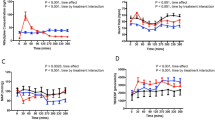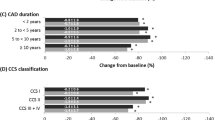Abstract
Imdur® (IMD) is a sustained-release isosorbide 5-mononitrate preparation for the treatment of chronic stable angina pectoris. Controlled medication release is achieved using the Durules® principle of insoluble matrix embedding.
Data from randomised double-blind trials show that IMD 60mg once daily (the most widely studied dosage) has significant antianginal and anti-ischaemic effects compared with placebo after 2 weeks’ treatment. Efficacy was generally observed ≈1 to 12 hours after administration, indicating that once-daily administration in the morning will provide effective prophylaxis of symptoms throughout the day. Improvements from baseline are generally maintained during IMD repeated treatment. There was no evidence of classical tolerance to IMD 30 to 240 mg/day in a large well designed study. Although improvements from baseline were maintained over 6 weeks with IMD 30 or 60 mg/day, statistical significance versus placebo was eventually lost because of improved performance in the placebo group. IMD 120 or 240 mg/day were more effective than placebo after 6 weeks. Studies lasting up to 2 weeks found no evidence of tolerance to IMD 60 mg/day.
In comparative trials lasting ≈2 weeks, IMD 60mg once daily was more effective than isosorbide dinitrate 30mg 4 times daily and similar to or better than isosorbide dinitrate 20mg 3 times daily. Preliminary data show that IMD 60mg once daily has similar efficacy to diltiazem 60mg 3 times daily and is at least as effective as certain other sustained-release isosorbide 5-mononitrate preparations.
There is no evidence for rebound worsening of ischaemia 24 hours after IMD administration. Abrupt discontinuation during long term IMD treatment may exacerbate anginal symptoms.
In general, IMD is well tolerated. The most frequently reported adverse event, headache, is usually mild to moderate, improves with long term therapy and rarely leads to treatment withdrawal. Patient compliance is better with once-daily administration of IMD than with twice-daily administration of conventional isosorbide 5-mononitrate.
Conclusions: In patients with chronic stable angina, IMD provides effective antianginal prophylaxis for up to 12 hours and does not seem to be associated with rebound phenomena at the end of the dosage interval. Improvements from baseline are maintained during repeated administration, although loss of statistically significant superiority over placebo was evident during 6 weeks’ treatment with IMD ≤60 mg/day in 1 study. Further evaluation of comparative efficacy (particularly with respect to other sustained-release preparations) and long term effects would be beneficial. Nevertheless, the available data suggest that IMD is a useful and convenient agent for the treatment of patients with chronic stable angina pectoris.
Similar content being viewed by others
References
Parker JO. Eccentric dosing with isosorbide-5-mononitrate in angina pectoris. Am J Cardiol 1993; 72: 871–6
Thadani U, Maranda CR, Amsterdam E, et al. Lack of pharmacologic tolerance and rebound angina pectoris during twice-daily therapy with isosorbide-5-mononitrate. Ann Intern Med 1994; 120(5): 353–9
Jonsson UE. Development of long-acting nitrate delivery systems. Eur J Clin Pharmacol 1990; 38 Suppl. 1: S15–9
Sjögren J. Studies on a sustained release principle based on an inert plastic matrix. Acta Pharm Suec 1971 (8): 153–68
Task Force of the European Society of Cardiology. Management of stable angina pectoris: recommendations of the Task Force of the European Society of Cardiology. Eur Heart J 1997 Mar; 18: 394–413
Brunelli C, Cristofani R, L’Abbate A. Long-term survival in medically treated patients with ischaemic heart disease and prognostic importance of clinical and electrocardiographic data. Eur Heart J 1989; 10: 292–303
Rehnqvist N, Hjemdahl P, Billing E, et al. Effects of metoprolol vs verapamil in patients with stable angina pectoris: the Angina Prognosis Study in Stockholm (APSIS). Eur Heart J 1996; 17: 76–81
Dargie HJ, Ford I, Fox KM. Total Ischaemic Burden European Trial (TIBET). Effects of ischaemia and treatment with atenolol, nifedipine SR and their combination on outcome in patients with chronic stable angina. Eur Heart J 1996; 17:104–12
Torfgård KE, Ahlner J. Mechanisms of action of nitrates. Cardiovasc Drugs Ther 1994 Oct; 8: 701–17
Parker JD, Parker JO. Nitrate therapy for stable angina pectoris. Drug Ther 1998; 338(8): 520–31
Fung H-L, Chung S-J, Bauer JA, et al. Biochemical mechanism of organic nitrate action. Am J Cardiol 1992; 70: 4B-10B
Harrison DG, Bates JN. The nitrovasodilators: new ideas about old drugs. Circulation 1993; 87: 1461–7
Abrams J. Mechanisms of action of the organic nitrates in the treatment of myocardial ischaemia. Am J Cardiol 1992; 70: 30B-42B
Wagner F, Siefert F, Trenk D, et al. Relationship between pharmacokinetics and hemodynamic tolerance to isosorbide-5-mononitrate. Eur J Clin Pharmacol 1990; 38 Suppl. 1: S53–9
Parker JD. Counterregulatory responses: sustained-release isosorbide-5-mononitrate versus transdermal nitroglycerin. J Cardiovasc Pharmacol 1996 Nov; 28: 631–8
Wisenberg G, Roks C, Nichol P, et al. Sustained effect of and lack of development of tolerance to controlled-release iso-orbide-5-mononitrate in chronic stable angina pectoris. Am J Cardiol 1989 Sep 15; 64: 569–76
Iversen HK, Nielsen TH, Garre K, et al. Dose-dependent headache response and dilatation of limb and extracranial arteries after three doses of 5-isosorbide-mononitrate. Eur J Clin Pharmacol 1992 Jan; 42: 31–5
Kampmann JP. Pharmacokinetics of various preparations of organic nitrates. Drugs 1987; 33 Suppl. 4: 5–8
Chasseaud LF. Isosorbide 5-mononitrate pharmacokinetics. Cardiology 1987; 74 Suppl. 1: 6–11
Jonsson UE. Various administration forms of nitrates and their possibilities. Drugs 1987; 33 Suppl. 4: 23–31
Kosoglou T, Patrick JE, Cohen A, et al. Pharmacokinetics of isosorbide-5-mononitrate after oral administration of an extended-release mononitrate formulation versus a standard dinitrate formulation. Clin Ther 1995 Mar–Apr; 17: 241–51
Rutherford JD. Nitrate tolerance in angina therapy: how to avoid it. Drugs 1995 Feb; 49: 196–9
Kertland H. Nitrate tolerance — mechanisms and prevention. Conn Med 1993; 57(4): 232–4
Thadani U. Nitrate tolerance, rebound, and their clinical relevance in stable angina pectoris, unstable angina, and heart failure. Cardiovasc Drugs Ther 1996 (10): 735–42
Kosoglou T, Kazierad DJ, Schentag JJ, et al. Effect of food on the oral bioavailability of isosorbide-5-mononitrate administered as an extended-release tablet. J Clin Pharmacol 1995 Feb; 35: 151–8
Nyberg G, Blychert L-O, Jonsson UE. Pharmacokinetics of isosorbide-5-mononitrate in a controlled-release (Durules) formulation. Br J Clin Pharmacol 1985; 20(5): 541P
Chrysant SG, Glasser SP, Bittar N, et al. Efficacy and safety of extended-release isosorbide mononitrate for stable effort angina pectoris. Am J Cardiol 1993 Dec 1; 72: 1249–56
Glasser SP, Imdur Study Group. Effect of extended-release isosorbide mononitrate one hour after dosing in patients with stable angina pectoris. Am J Cardiol 1997 Dec 15; 80: 1546–50
Uusitalo A, Keyriläinen O, Harkonen R, et al. Anti-anginal efficacy of a controlled-release formulation of isosorbide-5-mononitrate once daily in angina patients on chronic β-blockade. Acta Med Scand 1988; 223: 219–25
Nordlander R, Walter M, Swedish Multicentre Group. Once-versus twice-daily administration of controlled-release isosorbide-5-mononitrate 60 mg in the treatment of stable angina pectoris: a randomized, double-blind, cross-over study. Eur Heart J 1994 Jan; 15: 108–13
Svendsen JH, Aldershvile J, Abildgaard U, et al. Efficacy of controlled-release isosorbide-5-mononitrate as adjunctive treatment to β-blocking agents in patients with stable angina pectoris. J Cardiovasc Pharmacol 1989 Sep; 14: 358–63
Deeg P, Becker B, Feldmann M, et al. Antianginal effect of isosorbide-5-mononitrate given as monotherapy in angina pectoris: a comparison of two different once-daily formulations. Drug Invest 1993 Oct; 6: 231–6
Eteiba H, Hutton I, Foale RA, et al. Acute and chronic effects of once-daily isosorbide-5-mononitrate on the exercise capacity of patients with angina pectoris treated with a beta-blocking drug. Br J Clin Pract 1991; 45(3): 185–8
Seabra-Gomes R, Aleixo AM, Adao M, et al. Comparison of the effects of a controlled-release formulation of isosorbide-5-mononitrate and conventional isosorbide dinitrate on exercise performance in men with stable angina pectoris. Am J Cardiol 1990 Jun 1; 65: 1308–12
Engby B, Dehlholm B, Bötker H-E, et al. Stable angina treated with isosorbide-5-mononitrate, Durules, diltiazem or the combination [abstract]. Eur Heart J 1989 Aug; 10: 72
Thadani U, Lipicky RJ. Short and long-acting oral nitrates for stable angina pectoris. Cardiovasc Drugs Ther 1994 Aug; 8: 611–23
Nyberg G, Carlens P, Lindström E, et al. The effect of isosorbide-5-mononitrate (5-ISMN) Durules registered on exercise tolerance in patients with exertional angina pectoris: a placebo controlled study. Eur Heart J 1986; 7(10): 835–42
Parker JO. Controlled release isosorbide-5-mononitrate in angina pectoris: a comparison with standard formulation isosorbide dinitrate. Can J Cardiol 1991 Apr; 7: 125–30
Olsson G, Allgén J, Amtorp O, et al. Absence of pre-dose rebound phenomena with once daily 5-ISMN in a controlled-release formulation. Eur Heart J 1992 Jun; 13: 814–7
Rehnqvist N, Olsson G, Engvall J, et al. Abrupt withdrawal of isosorbide-5-mononitrate in Durules (Imdur) after long term treatment in patients with stable angina pectoris. Eur Heart J 1988 Dec; 9: 1339–47
Brun J. Patient compliance with once-daily and twice-daily oral formulations of 5-isosorbide mononitrate: a comparative study. J Int Med Res 1994 Sep–Oct; 22: 266–72
Beran YM, Richardson PDI. Enhanced control of angina pectoris in general practice: once-daily treatment with isosorbide mononitrate (Imdur) as Durules. Clin Trials J 1989; 26(1): 23–32
Meffert M, Paeckelmann I-M. Experience of long term treatment and different dosage regimens of isosorbide-5-mononitrate. Drugs 1987; 33 Suppl. 4: 104–10
Astra Hässle AB. Slide Resource Imdur. Astra Hässle AB (Mölndal), 1996. (data on file)
Thadani U, Chohan A. Chronic stable angina pectoris: strategies for effective drug therapy. Postgrad Med 1995 Dec; 98: 175–88
Beta-Blocker Pooling Project Research Group. The Beta-Blocker Pooling Project (BBPP): subgroup findings from randomized trials in post infarction patients. Eur Heart J 1988; 9: 8–16
Beyerle A, Reiniger G, Rudolph W. Long-acting, marked anti-ischemic effect maintained unattenuated during long-term interval treatment with once-daily isosorbide-5-mononitrate in sustained-release form. Am J Cardiol 1990 Jun 15; 65: 1434–7
Guzik J, Kanopka M, Maciejewicz J, et al. Sustained-release isosorbide-5-mononitrate improves exercise capacity 30 minutes after oral application. Clin Drug Invest 1997 Aug; 14: 117–24
Kenedi P, Gathmann-Lewik U. Dose-effect relationship amongst three different sustained-release forms of isosorbide 5-mononitrate in patients with coronary artery disease. Cardiology 1987; 74 Suppl. 1: 29–33
Heepe W, Gathmann-Lewik U. Antianginal efficacy and tolerability of 50 mg sustained-release isosorbide 5-mononitrate in an open twelve-month observation study. Cardiology 1987; 74 Suppl. 1: 34–9
Ahmadinejad M, Eghbal B, Sorgenicht W, et al. Slow-release isosorbide-5-mononitrate — a new once daily therapeutic modality for angina pectoris. Eur Heart J 1988 Jan; 9 Suppl. A: 135–9
DeMots H, Glasser SP. Intermittent transdermal nitroglycerin therapy in the treatment of chronic stable angina. J Am Coll Cardiol 1989; 13(4): 786–95
Thadani U. Medical therapy of stable angina pectoris. Cardiol Clin 1991; 9(1): 73–87
Author information
Authors and Affiliations
Corresponding author
Additional information
Use of trade name is for product identification purposes only and does not imply endorsement.
Rights and permissions
About this article
Cite this article
Gunasekara, N.S., Noble, S. Isosorbide 5-Mononitrate. Drugs 57, 261–277 (1999). https://doi.org/10.2165/00003495-199957020-00016
Published:
Issue Date:
DOI: https://doi.org/10.2165/00003495-199957020-00016




